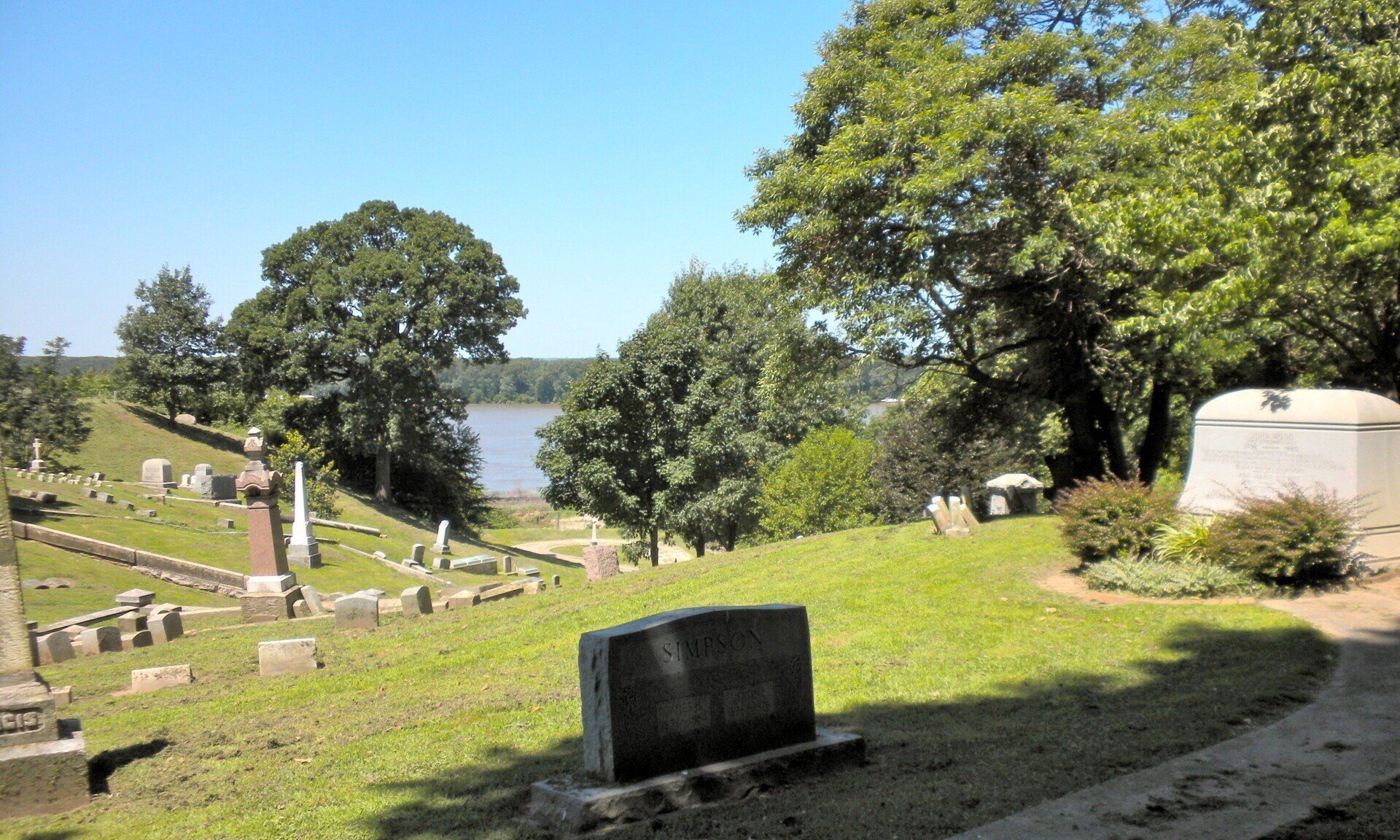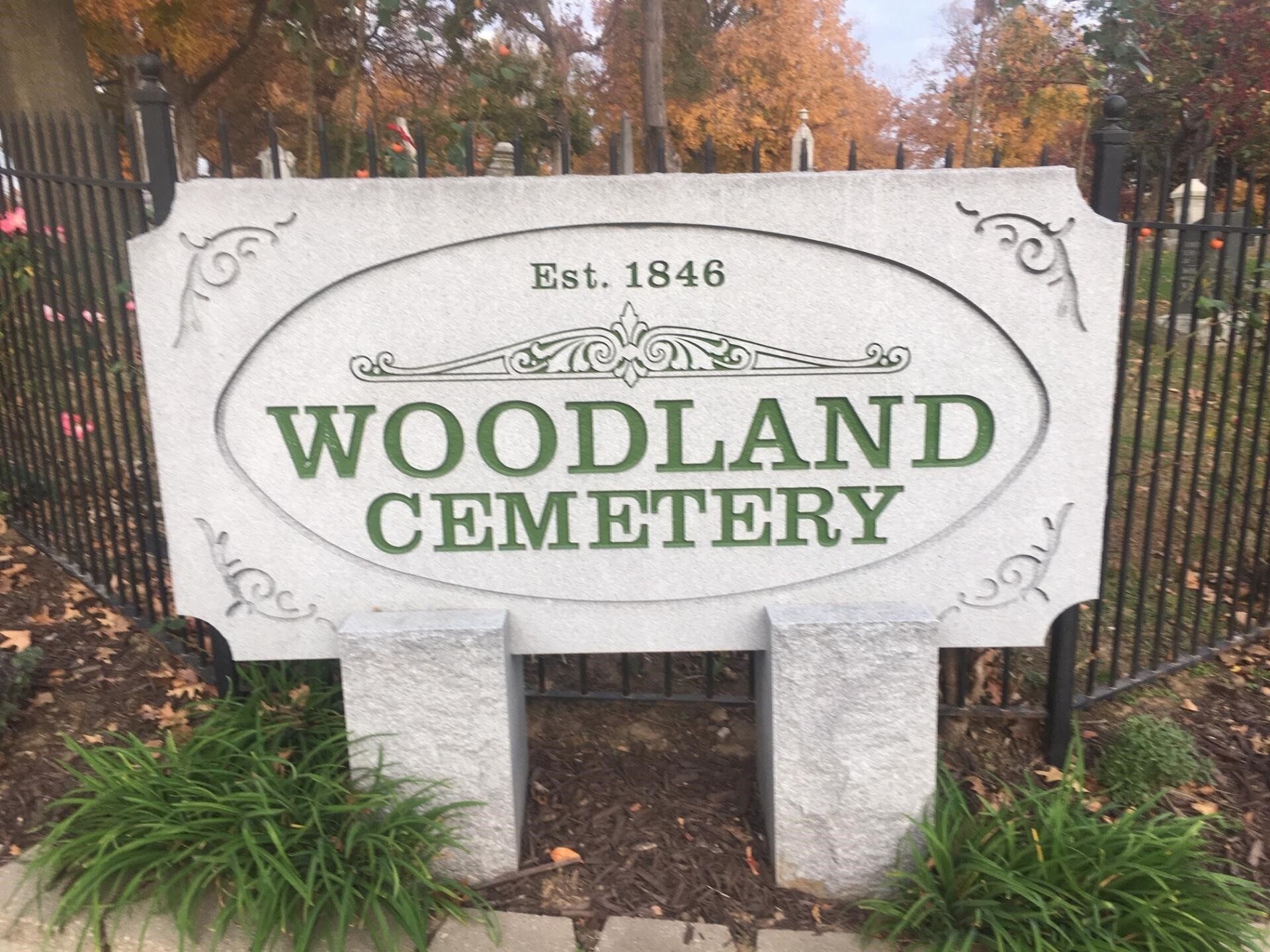A Quincy Architectural Gem: Woodland Cemetery

View of the hills of Woodland Cemetery and the Mississippi River.(Public Domain)
John Wood was 48 years old in 1846 when he began thinking about his own mortality. By then his eight children had been born and three had died. His father Daniel, who had served in the Revolutionary War, died in 1843.
The first two decades of Wood's life in Quincy were a whirlwind of building a city and county, a portfolio of real estate assets, and a farm. His interests were widespread. Lorenzo Bull, at 14, arrived in Quincy and saw Wood's stamp throughout the city. "Wood was a very energetic, active young man," Bull recalled many years later, "always on the move, and who seemed to be everywhere, all over the town, all over his large farm, driving and pushing everything and everybody about him."
John Wood was, said Bull, a force of nature. He remembered that Wood's voice was loud and strong and his laugh exuberant and unrestrained, known by everyone in town. Bull said he asked a man one morning if he had seen Wood in town. The man answered he had not seen him but figured he had to be there. "I heard him whisper," the man said.
At the time he laid out the cemetery in 1846, Wood was mayor of the city he and Willard Keyes founded. Wood sought a place his community could memorialize its dead.
Hills and valleys rolled across the limestone bluff high over the Mississippi River at the place Wood chose for his cemetery. The terrain was just as he had found it nearly a quarter century earlier. Sentiment dictated the spot. Just north was the younger Wood's first home, a simple one-room log cabin on the southeast corner of today's Front and Delaware Streets.
Within three years of Wood organizing the cemetery, cholera hit Quincy and killed some 400 citizens. Most of the victims were buried quickly in Woodland without permits in unmarked graves. When the city began construction of Jefferson Street between Front and Fifth Street on the north side of the cemetery, the bones of many cholera victims were exposed on the slope.
In 1900, when the hillside along Jefferson washed out once again and the remains of veterans were exposed, the War Department ordered the removal of 390 bodies of soldiers from Woodland, a national military cemetery since 1861, to Graceland Cemetery.
Woodland holds many graves of men who fought in the nation's wars. Martin J. Hawkins, a Congressional Medal of Honor winner in the Civil War, is there. So is James Dada Morgan, a brevetted Civil War major general beloved by his men for never asking them to do what he would not do himself. And Capt. John M. Cyrus of Camp Point, who fought with the 50th Illinois Infantry at Shiloh, is there.
Several congressmen are there, including George Alburtus Anderson, Orville Hickman Browning, John Montgomery Glover, Isaac Newton Morris and William Alexander Richardson. Illinois Supreme Court Justice Onias Childs Skinner is buried there.
There, too, are many Quincy women honored for their spirit of industry, benevolence and pioneering. Among them are Sarah Denman, founder of Blessing Hospital, the women's study group, Friends in Council and the Civil War's benevolent Needle Pickets; Abby Fox Rooney, the first woman licensed to practice medicine in Illinois; and Candace Reed, a business woman whose photography is prized among collectors. Alongside her husband, U.S. Sen. Orville Browning, is Eliza Caldwell Browning, particularly noted for her twenty-eight-year friendship with Abraham Lincoln.
The humble rest near the honored. In his diary on Sept. 7, 1858, Browning wrote, "Another bright, warm, beautiful day. Old Aunt Polly, our colored woman, died this a. m. between 12 & 1 O'clock, and was buried in Woodland Cemetery at 4 p.m."
Wood planted a white oak tree at the center of the cemetery. It was the site that he chose for his final resting place. Several members of his family are buried within fifteen feet of the tree, including Wood's father Daniel, whose body John Wood brought in 1860 from its Cayuga County, NY grave to Quincy.
Cemeteries were not only places of repose for the deceased. They were considered places of reflection and meditation for those who wished to visit. Wood was impressed with the Victorian period that began in 1837 and brought with it artistic stylizations that were applied to tombstones and monuments, saying something about the deceased.
On either side of the monument over the grave of Gottlieb Arning are an anvil and a quenching pot, representing the life's work of the blacksmith. A sleeping child and lamb represent ten of the fourteen children of the William King family who died before they reached the age of 10.
Wood, who installed himself as the cemetery's caretaker for the next thirty-five years of his life, spent considerable time there, sitting in the office in a woven-reed chair. As it is today, the cemetery was a quiet place. Wood considered it a sacred place. In a "Notice to the Public" in the Quincy Daily Whig of May 27, 1854, he asked that visitors respect the sanctity of the cemetery, that they not pick the shrubs and flowers from around the graves or hitch their horses to growing trees or take sod from the burial places.
At 11:15 a.m. June 4, 1880, Wood died "crowned with the honors of a long and eventful life," as the Daily Whig put it. The city was draped in black. Businesses and school closed. Thousands lined the route of procession from the Congregational Church to the grave beneath the shade of the white oak tree at the heart of Woodland Cemetery.
John Wood's body was laid to rest at the place he had chosen. Over his grave was a simple monument, a thin sculpture on its face as Wood had directed. It was his one-room log cabin, symbol of a humble life. The stone, reflecting the way Wood wanted to be remembered, was stolen from his grave early in the next century.
Sources
Browning, Orville H. The Diary of Orville Hickman Browning, Vol 1. Edited by Theodore Calvin Pease . Springfield: Illinois State
Historical Society, 1925.
Bull, Lorenzo. Personal Recollections of Quincy and Its Earliest Settlers as I Knew Them in 1833. Paper presented at the Annual
Meeting of the Historical Society of Quincy, 1903 of Lorenzo Bull," May 1, 1903. MS File 920, Bull Lorenzo, Historical Society of Quincy and Adams County.
Collins, William H. and Cicero F. Perry. Past and Present of the City of Quincy and Adams County, Illinois. Chicago: The S. J. Clarke
Publishing Co., 1905.
"Dead: Death of Ex-Governor John Wood in this City." Quincy Daily Whig, June 10, 1880.
The History of Adams County, Illinois. Chicago: Murray, Williamson & Phelps, 1879.
Landrum, Carl. "The Story of Woodland Cemetery." Quincy Herald-Whig, April 6, 1980.
"To the Public," Quincy Daily Whig, May 27, 1854.
Woodland Cemetery, Quincy, Illinois. Illinois Historic Preservation Agency, 2005

The sign at the entrance of Woodland Cemetery (Courtesy of Woodland Cemetery)






